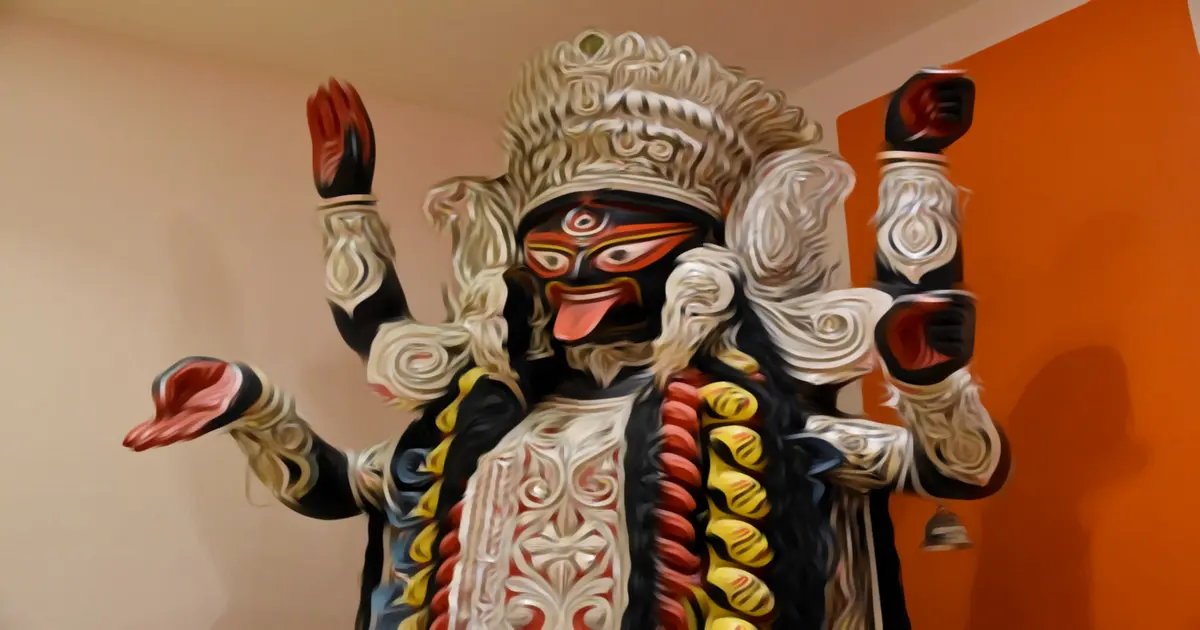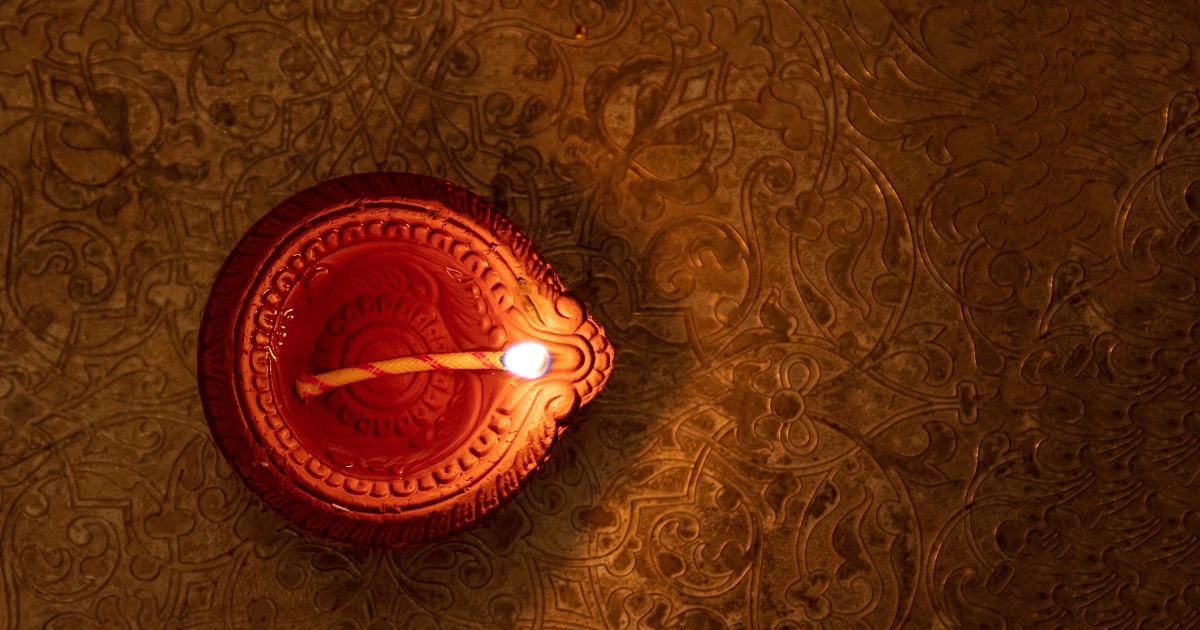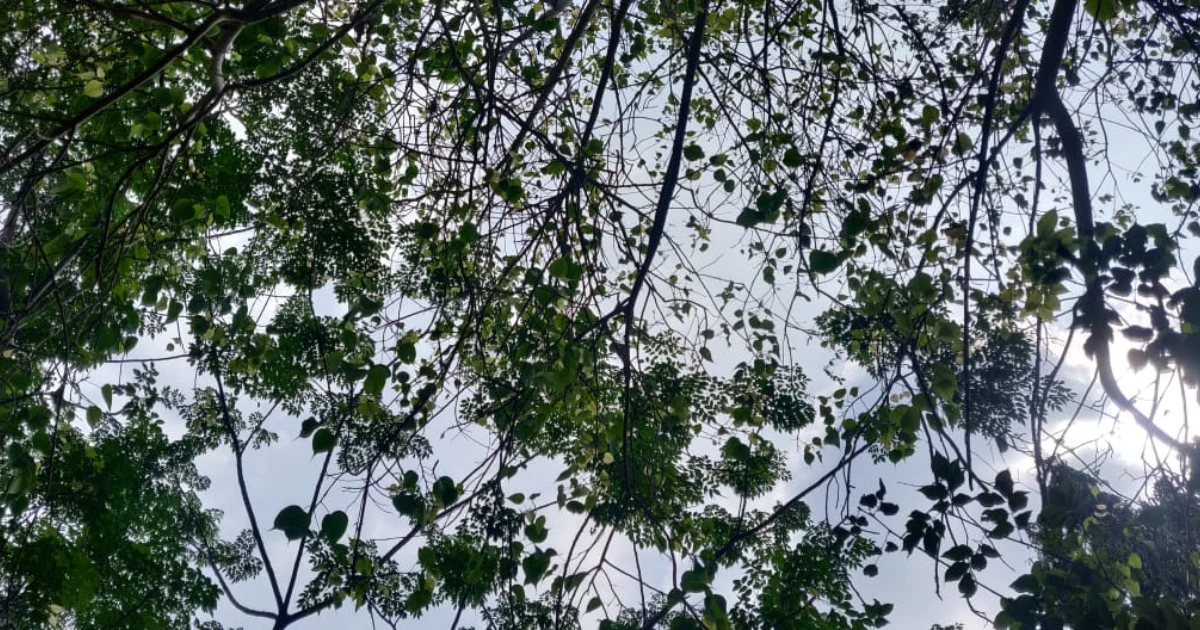शवारूढां महाभीमां घोरदंष्ट्रां हसन्मुखीं।
चतुर्भुजां खड्गमुण्डवराभयकरां शिवाम्॥१॥
मुण्डमालाधरां देवीं ललजिह्वां दिगम्बराम्।
एवं सञ्चिन्तयेत्कालीं शामशानालयवासिनीम्॥२॥Śavārūḍhām mahābhīmāṃ ghoradaṁṣṭrāṁ hasanmukhīm ।
Caturbhujāṃ khaḍgamuṇḍavarābhayakarāṁ Śivām ।।1।।
Muṇḍamālādharāṃ devīṁ lalajihvāṃ digambarām ।
Evaṁ sañcintayetkālīṁ śmaśānālayavāsinīm ।।2।।My heart is absorbed in the thoughts of Śrī Kālī. She resorts in śmaśāna, Devī is adorned with skull-garland and her tongue constantly flickers ||2||
Śrī Śivā holds a sword and head in two hands & blesses and protects with other two. While presiding over a corpse she has a smiling, beautiful face ||1||
काली | Kālī
The etymological origin of Kālī is kāla. This root word has five meanings: kṣepa, jñāna, saṁkhyāna, gati and nāda. These five tell us about the five attributes of Bhagavatī. She does kalana in these five ways, hence she is Bhagavatī Śrī Kālī or Bhagavatī Śrī Kālakarṣiṇī-
क्षेपो ज्ञानं च संख्यानं गतिर्नाद इति क्रमात्॥१७३॥
स्वात्मनो भेदनं क्षेपो भेदितस्याविकल्पनम्।
ज्ञानं विकल्पः संख्यानमन्यतो व्यतिभेदनात्॥१७४॥
गतिः स्वरूपारोहित्वं प्रतिबिम्बवदेव यत्।
नादः स्वात्मपरामर्शशेषता तद्विलोपनात्॥१७५॥
इति पञ्चविधामेनां कलनां कुर्वती परा।
देवी काली तथा कालकर्षिणी चेति कथ्यते॥१७६॥
Kāśmīrīya Śaivādvaya talks about twelve forms of Śrī Bhagavatī. These are due to the pramātā, pramāṇa and prameya stages of sṛṣṭi, sthiti, saṁhāra and anākhya. Of the ten sense organs, mana (mind) and buddhi (intellect) are another manifestation of these twelve forms.
In the rest of Bhārata, these forms are known by different names and variations; however, all the forms of Bhagavatī are one.
In Śrī Mahānirvāṇa Tantra, it is mentioned that one who does kalana of all is Śrī Mahākāla and the one who does kalana of Śrī Mahākāla Himself is Bhagavatī Parā Śrī Ādi Kālī. It is also said that she eats away even the kāla while being the Ādi form of all. Being the source of kāla and existents, she is called as Bhagavatī Śrī Kālī-
कलनात्सर्वभूतानां महाकालः प्रकीर्तितः ।
महाकालस्य कलनात्त्वमाद्या कालिका परा॥३१॥
कालसंग्रसनात्काली सर्वेषामादिरूपिणी।
कालत्वादादिभूतत्वादाद्याकालीति गीयते॥३२॥
In Śrī Kālī Tantra she is called as administrator of kāla and giver of tattva jñāna:
कालनियन्त्रणात् काली ज्ञानतत्त्वप्रदायिनी।
तस्मात् सर्वप्रयत्नेन यजेदुभयसिद्धये॥१८॥
श्मशान | śmaśāna
Bhagavatī Kālī is associated with the श्मशान (śmaśāna, charnel ground). In general, this is the place where the dead bodies are brought and then cremated. Here श्म (śma) indicates ‘remains’ and शान means ‘to destroy’. It is the place where the jīvātmā gets completely free from the carnal body, as well as the associated effects of that body like heat and cold, joy and sorrow. Calling this place as the residence of Bhagavatī is significant: as one gives up all the carnal associations, one would see that Mother waiting.
Śmaśāna is meaning of the chummakā1 called ḍāmara. Kṣemarāja says this śmaśāna is the place of vīracaryā where all the doubts and fear are slayed, and hence being uḍḍāmara this is called as ḍāmara:
किञ्च वीरचर्यास्थानम् –
श्मशानं डामरं ज्ञेयं
समस्तशङ्कातङ्कत्रोटकत्वेन उड्डामरत्वाद् डामरं।
So the śmaśāna is symbolic to the state where the seeker earns the viveka, the power of proper discrimination. Once the sādhaka reaches to this stage, Bhagavatī herself greets that sādhaka with complete love and affection.
देवी | Devī
In general, this shabda (word) means Goddess. As per Abhinavagupta, Devī is Parā Bhagavatī Saṁvita who displays the world as idantā (another object) in the three forms Paśyantī, Madhyamā and Vaikharī, with her sva, and even then doesn’t lose her real form-
अहम्’ इति चमत्कृतिःअन्तःकृत-अनन्त-विश्व-इदन्ताचमत्कृतिपूर्णवृत्तिः तत् पश्यन्ती-मध्यमात्मिका स्वात्मानम् एव वस्तुतः परसंविदात्मकं विमृशति। परा एव च संवित – ‘देवी’ इति उच्चते।
The word Devī has evolved from root word div. This root word has six meanings: krīḍā (to sport), vijīgiṣā (desire to win), vyavahāra (business), dyuti (to project or display), stuti (to worship) and gamana (transmigration):
- Parā Śakti displays the entire world with Herself as a separate entity. This is the sport of Māṁ Bhagavatī.
- As the Parameśvara Bhairava is supreme and his Iccchā Śakti also resorts within him to keep him supreme, She is the desire to win.
- Bhagavatī drives various kinds of jñāna, impressions of memories, doubts, and more; hence, She is into the business of operations.
- Parā Śakti projects Herself as the essence of subjective and objective existence. This is Her attribute, to display.
- All the subjective and objective forms of Parā Śakti are involved in Her worship (in the form of any kind of exchange), so it can be said that She Herself worships Her.
- After creating various existences, She transmigrates from one body to another.
मुण्डमाला | muṇḍa-mālā
Meaning a garland made of skulls, Śrī Kālī’s garland has fifty skulls which represent the fifty letters of Mātṛkā. As the Mātṛkā is in Vaikharī form and as the entire world has evolved from Mātṛkā, the human skull is the composition of paratattva in sahasra-kamala, it is the sense of the organs. The entire creation from Śiva to pṛthvi is used to represent the Mātṛkā. Being in garland form is significant, as these Mātṛkās proudly dedicate themselves to adorn the Bhagavatī Parābhaṭṭārikā. This garland is Śrī Mātṛkā Cakra and the Bhagavatī is Śrī Śrī Cakreśvarī.
शिवा | Śivā
The Śakti of Śiva is Śivā. It is said that this world is precisely the Śakti, and the Śaktimāna is Maheśvara:
शक्तिश्च शक्तिमांश्चेति पदार्थद्वयमुच्यते।
शक्तयोऽस्य जगत् सर्वं शक्तिमांस्तु महेश्वरः॥
All the activities of the world are done by Śakti; and Śiva resorts in inert state, so it is said that Mantra or sādhanā shall be offered to Śakti even if it is for Parameśvara Śiva. This is the reason why She called as the mukha or gateway of Śiva. However, to enter in this stage, the giving up of one’s individual identity is a must. Again, this is the reason why She is seen as standing in charnel ground:
शक्त्यावस्थाप्रविष्टस्य निर्विभागेन भावना।
तदासौ शिवरूपी स्यात् शैवी मुखमिहोच्यते॥२०॥
खड्ग | khaḍga
The khaḍga or sword held by Mother is not an ordinary one. It is jnana khaṅga, the sword of the intellect, which slays the illusions. Hence, Bhagavatī is Jñāna Vigrahā - the embodiment of the intellect. This jñāna is the inner power of the seeker. This is one of the reasons why the seeker exhibits khaṅga mudrā:
अन्तः शक्तिकृपाणीं व्यनक्षि संसृतिविभेदिनीमसिना।
निजशक्तिमहिमस्वीकृत समस्ताविश्वा हि वीरवराः॥
मुण्ड | muṇḍa
The human head comprises of eyes, ears, nose and mouth. It also consists of the sahasrāra cakra and bhramabila. Hence, She who holds human head signifies that She controls both the path of mokṣa and the path of indulgence. She alone is Parābhaṭṭārikā, who manifests herself as Parā, Parāparā and Aparā.
वर | vara
Blessings. What else is it that Mother has for Her children? Śrī Śrī Parātriṁśikā says that the One who is capable of the five acts- creation, operation, destruction, confinement and grace- that One alone is Parābhaṭṭāraka or Parābhaṭṭārikā. Even though the five are done eternally, there is anugraha (grace) only behind all the five. This is represented by vara mudrā, and Bhagavatī is depicted as blessing Her children; always.
अभय | abhaya
Ensuring protection: In Śrī Durgā Saptaśatī, it is mentioned that She is the mother of the entire world. Whosoever is seen as giving refuge to others is empowered by Bhagavatī only:
रोगानशेषानपहंसि तुष्टा रुष्टा तु कामान् सकलानभीष्टान्।
त्वामाश्रितानां न विपन्नराणां त्वामाश्रिता ह्याश्रयतां प्रयांति॥२९॥
Wherever or whatever the situation, whether surrounded by snakes, enemy or looters, whether trapped in forest fire or in the ocean, you stay there and protect the world, hence, She would always protect you:
रक्षांसि यत्रोग्रविषाश्च नागा यत्रारयो दस्युबलानि यत्र।
दवानालो यत्रतथाब्धिमध्ये तत्र स्थिता त्वं परिपासि विश्वं॥३२॥
शवारूढ़ा | Śavārūḍḥā
The corpse is Her vāhanā or vehicle.
Firstly to be analyzed is- what is a corpse? Whose corpse is it? When the first question would be answered, the second would be answered on its own.
Corpse: In general, the corpse is a dead body, that body without any capability or Śakti. In Śrī Saundarya Laharī this fact is mentioned in the very first śloka as:
शिवः शक्त्या युक्तो यदि भवति शक्तः प्रभवितुं
न चेदेवं देवो न खलु कुशलः स्पंदितुमपि |
अतस्त्वाम् आराध्यां हरि-हर-विरिन्चादिभि रपि
प्रणंतुं स्तोतुं वा कथ-मुक्त पुण्यः प्रभवति ||१||
Śiva without Śakti only is Śava. While looking at the thirty-six tattvas, it can be clearly observed that at first (Śiva level), Śiva and Śakti are one; though at the level of Sadāśiva, He appears as separate from Śakti. This Śadāśiva form alone is called as śava here. He is also called as Mahāpreta because:
As He comprises of all the tattvas up to Īśvara within, he is called as Mahāpreta:
रुद्रोर्ध्वे चेश्वरं देवं तदूर्ध्वे च सदाशिवं।
न्यसेत्स च महाप्रेत इति शास्त्रेषु भण्यते॥३०९॥
समस्ततत्त्वव्याप्तृत्वान्महाप्रेतः प्रबोधतः।
प्रकर्षगमनाच्चैष लीनो यन्नाधरं व्रजेत॥३१०॥
His mahatva (might) and pervasion as tattvas alone made Him Mahāpreta.
Moreover, there is significance behind this name Mahāpreta. Preta is a transmigrating soul and as Sadāśiva tattva represents the transmigration from impure adhvā to pure adhvā, plus this tattva is the cause behind supreme transition, he called as Mahāpreta.
Hence, the śava is Mahāpreta Sadāśiva, and when the Bhagavatī puts Her feet on his chest, he reaches to the level of Śiva.
In Śrividyā sādhanā the Bhagavatī is contemplated upon as sitting on Sadāśiva, while here as Kālī She is seen as standing on Sadāśiva. Both are eternally the same. In Kāśmīrīya Śaivādvaya it is said that Bhagavatī Parābhaṭṭārikā- the one who manifests as Parā, Parāparā and Aparā- sits on the trident blown out of the naval of Sadāśiva:
तस्य नाभ्युत्थितं शक्तिशूलश्रृड़्गत्रयं स्मरेत्।
कखत्रयेण निर्यातं द्वादशन्तावसानकम्॥६९॥
This is the reason why seekers are supposed to perform sādhanā on pañcamuṇḍī āsana2.
हसन्मुखी | Hasanmukhī
She with the laughing face: The mother is always happy to protect and help her child. She would always be happy when She would see that Her child is on the right path. As the seeker who is none other than Her child traversing on this serene right path, She is happy.
The above reflections are a small effort to look at the real form of Mother. One should not stop here, as this is just a glimpse. Her real form can not be captured in words. It is the duty of her dutiful child to explore more and more, for the sake of Her grace.
FootNote:
- chummakā is a type of encoded word usage found in Kāśmīrīya Śaiva Tantra śastra.
- The 'Śrī Śrī Navamuṇḍī Mahāsana' article written by M.M. Gopinath Kaviraj provides a better understanding of this aspect.






